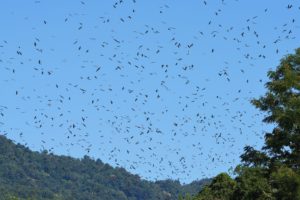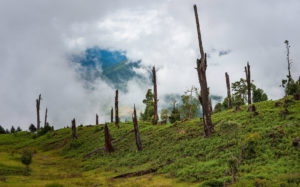Biodiversity – the diversity of ecosystems, species and genes – underpins the processes that make life possible. Biodiversity is the basis of our livelihoods and economy. At least 40% of the world’s economy and 80% of the needs of the poor are derived from biological resources. In the Hindu Kush Himalayas, most rural communities typically depend on varied ecosystems services for their everyday life and overall wellbeing.
For instance, in the Mai Pokhari Ramsar site of eastern Nepal, 94% of households are dependent on fuelwood for cooking and heating, 88% are dependent on fodder for livestock, and 53% use leaf litter as bedding material for livestock and compost for agriculture. Equally important are the spiritual values attached to the sacred Mai Pokhari (Mother Pond). More than 90% of households say this is important for their overall wellbeing.
Yet the current scale of biodiversity loss is staggering. We are on the cusp of a sixth mass extinction, with biodiversity declining faster than at any time in human history and rates of extinction an estimated 1,000 times higher than the ‘natural’ rate of species loss.
Biodiversity loss is the most critical global environmental threat, along with climate change. Together, they threaten to undermine achievement of the Sustainable Development Goals that we have set for ourselves.
The loss of biodiversity is undermining the resilience of agricultural systems against climate shocks, pests and pathogens, and the health of our overall socio-ecological system by aggravating the social and economic consequences of climate risk.
Biodiversity under threat in the Hindu Kush Himalayas
The Hindu Kush Himalayas are facing multiple severe environmental threats. The region is a major hotspot for climate change and a ‘risk hotspot’ for climate-included disasters and hazards. The region also suffers from extreme degradation of terrestrial and freshwater ecosystems, especially through wetland degradation, deforestation and forest fragmentation, landslides, erosion and over-harvesting of natural resources.
For instance, large areas of high-altitude wetlands such as the Zoige wetland of the eastern Qinghai-Tibetan Plateau in China have been degraded and destroyed due to climate change and human activities ranging from artificial drainage to over-exploitation of peat and overgrazing.
These factors are directly and indirectly contributing to biodiversity loss, declining productivity and desertification in many areas.
The Hindu Kush Himalayas (HKH) are still a highly biodiverse region. As per the IUCN Red List, the HKH countries are home to a total of 300 critically endangered species, one step away from extinction in the wild.
Of these, the population of around 80% show a decreasing trend, and the status of 18% of species is unknown; only 2% of critically endangered species are increasing in number.
Biodiversity targets – a report card
Nonetheless, efforts have been made to halt the loss and conserve the diversity of life in the region. The eight HKH countries (Afghanistan, Bangladesh, Bhutan, China, India, Myanmar, Nepal and Pakistan) are parties to the UN Convention on Biological Diversity (CBD) and committed to implementing the Strategic Plan for Biodiversity (2011-2020).
The Strategic Plan for Biodiversity, formally adopted at the UN biodiversity summit held in 2010 in Japan’s Aichi prefecture, is an overarching global framework with 20 ambitious yet achievable targets. These are better known as the Aichi Biodiversity Targets.
On a global scale, the fifth edition of the CBD’s Global Biodiversity Outlook (GBO5) showed that none of the 20 targets have been fully achieved. Six have been achieved partially.
Reports submitted by HKH countries to the CBD secretariat show they have done better than some other countries. Most HKH countries (except Bangladesh and Pakistan) submitted their National Biodiversity Strategy and Action Plans (NBSAP) by the 2015 deadline.
Implementation is hugely dependent on international funding.
A recent policy dialogue and stocktaking showed some progress in protecting biodiversity in the Hindu Kush Himalayas region. On the declaration of protected areas, the global target is to have at least 17% of terrestrial and inland water areas, especially areas of particular importance for biodiversity and ecosystem services, under some form of protection by each country. Bhutan has already exceeded this target. Protected areas cover 51.44% of the country, up from 28.3% in 2010. Nepal has increased its protected areas to 23.39% from 17% in 2010.
Some other targets have been met partially. Gene banks have been set up; documentation and management of agrobiodiversity have improved; and there are better incentive-based conservation programmes and strategies.
The International Centre for Integrated Mountain Development (ICIMOD) facilitated a yak germplasm exchange programme, in which the government of Bhutan handed over two yak breeding bulls to Nepal and one to India in 2020.
But 10 of the Aichi targets have not been achieved by HKH countries to any meaningful extent. Differences between national and global indicators for ecosystem services and ecosystem resilience are a problem. So are a lack of awareness about the significance of biodiversity and of commitments made to the CBD.
Crucially, implementation is hugely dependent on international funding. This has not been forthcoming.
Prolonged conflict, political instability and unstable governments in the region have also been key obstacles in implementing the CBD.
Coming decade crucial for biodiversity
This year is crucial for renewing biodiversity conservation and restoration goals. Along with the launch of the UN Decade on Restoration 2021-2030 on World Environment Day, global leaders will agree on a post-2020 Strategic Plan for Biodiversity at the 15th summit of the CBD, scheduled in Kunming, China, this October.
The 2021-2030 global biodiversity framework will be a universal framework for actions. It will guide a country’s commitments, plans, actions and funding for the conservation of biodiversity, its sustainable use, and fair and equitable sharing of benefits.
Consensus on and commitment to this framework will be critical to halting the current unprecedented loss of biodiversity worldwide, and re-emphasising the importance of biodiversity for our wellbeing and sustainable development. Biodiversity, if conserved, managed, and used sustainably and equitably, remains one of the key answers to several global challenges, including climate change, food and water security, and emerging infectious diseases.
Transformative change for biodiversity and sustainable development
Transformative change is required to conserve agrobiodiversity and address food insecurity and malnutrition. Similarly, transformation is needed to promote sustainable forestry and fisheries.
These require collaboration and cooperation among a wide range of stakeholders. Greater regional cooperation and scaling up of a transboundary landscape approach can support conservation and sustainable use of biodiversity across the region.
The countries of the Hindu Kush Himalayas need to work together to stem biodiversity loss and restore landscapes to end poverty and improve human wellbeing.








